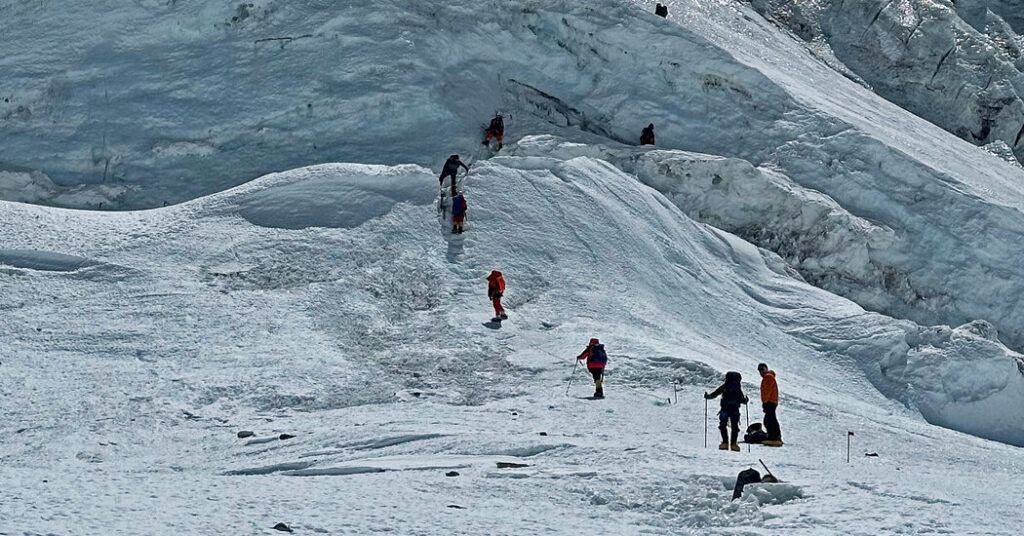High above the clouds on Earth’s highest peak, climbers are making the arduous trek up Mount Everest.
The narrow window of the spring summit season, which usually lasts from April to May, is the best time to climb. The weather is clearer and less windy but that is no guarantee of safety: At least five people have died and three others have gone missing since the beginning of this climbing season, officials said.
The conditions have led to bottlenecks as unnerving videos have circulated of long lines of climbers waiting precariously on a precipice.
The popularity of the climb has prompted concerns in recent years that overcrowding, competition and inadequate vetting of rookie climbers are making it even more dangerous.
More climbers are feared dead.
Most climbers take on the mountain from Nepal, a process that involves a 10-day trek to base camp, weeks acclimatizing to the altitude, and another week to push to the summit.
But the journey is grueling. More than 300 people are known to have died on Everest, and an estimated 200 of their bodies remain there because they were too hard to retrieve.
Last spring set a grim record as 18 people died, according to the Himalayan Database, a mountaineering body, making it the deadliest year in recent record-keeping.
At least five people have died this year, Nepali officials confirmed, and the figure could rise.
-
A Nepali climber, Binod Babu Bastakoti, 37, died on Wednesday just above a base for the summit attempt.
-
A Kenyan climber, Joshua Cheruiyot Kirui, 40, also died on Wednesday near the summit. Nawang Sherpa, a guide who was with him, remains missing.
-
A British climber, Daniel Paul Paterson, 40, and his Nepali guide, Pastenji Sherpa, 23, are missing after the collapse of an ice mound near the summit on Tuesday.
-
A Romanian climber, Gabriel Viorel Tabara, 46, died in his tent, also on Tuesday, at an advanced base camp.
-
Two Mongolian climbers, Usukhjargal Tsedendamba, 53, and Purevsuren Lkhagvajav, 31, died on May 13, while trying to summit Everest without supplemental oxygen and Sherpa guides.
The collapse of a snow cornice stranded lines of climbers.
A group was briefly stranded after a cornice collapsed near other climbers, causing several to fall.
Climbers descending from the summit on Tuesday passed the Hillary Step, a point at an altitude of about 8,800 meters, or 28,871 feet, when an ice mound collapsed near the South Summit of Everest.
Several climbers were able to get back up, but despite search efforts, the British climber, Mr. Paterson and his guide, Mr. Sherpa, were “unable to be recovered,” according to 8K Expedition.
Officials have not confirmed the two deaths but rescuing them alive would be difficult, Lakpa Sherpa, director for 8K Expedition, said on Saturday.
“On that day, there was traffic,” Mr. Sherpa said, adding that a lack of coordination caused a backup of at least 150 climbers. “People couldn’t wait. They tried to overstep.”
Vinayak Jaya Malla, a mountain guide who was on the peak on Tuesday, shared footage of climbers perched along a narrow ridge on the summit, and a climber apparently using a safety rope to haul themselves up in the snow.
“Many climbers were stuck in the traffic and oxygen was running low,” he said on social media, adding that four other climbers who nearly died were clipped onto the rope.
After the cornice collapsed, it was impossible to traverse it, he said. Eventually climbers descended using a new route.
Fewer permits were issued for climbers this year.
The climbing window this year is longer than last year’s, said Khimlal Gautam, an official at Everest base camp.
Permits were issued to 421 climbers this year, compared with 478 last year, he said. But it was difficult to say whether overcrowding had endangered climbers, he said.
“Obviously, Everest, especially Hillary Step, gets crowded when climbers try to compete to reach the summit,” Mr. Gautam said, adding that some climbers did not heed instructions to avoid crowds.


